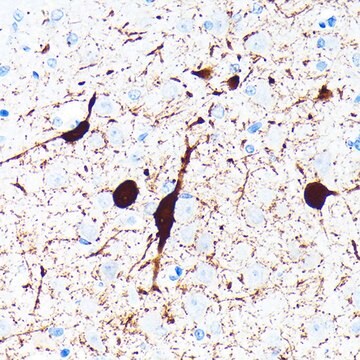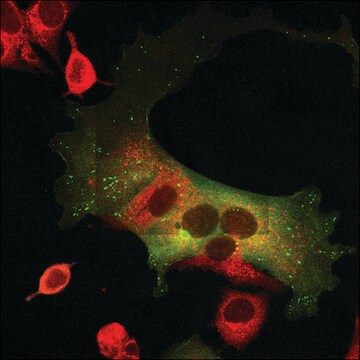추천 제품
생물학적 소스
rabbit
Quality Level
항체 형태
serum
항체 생산 유형
primary antibodies
클론
polyclonal
종 반응성
human, rat, sheep, chicken, mouse, bovine
제조업체/상표
Chemicon®
기술
ELISA: suitable
immunohistochemistry: suitable
western blot: suitable
NCBI 수납 번호
UniProt 수납 번호
배송 상태
wet ice
타겟 번역 후 변형
unmodified
유전자 정보
human ... YWHAG(7532)
일반 설명
Mammals express seven distinct 14-3-3 isoforms (gamma, epsilon, beta, zeta, sigma, theta, tau) that form multiple homo- and hetero- dimmers, thus rendering 14-3-3 as a key multifunctional regulatory molecule. 14-3-3 isomers have been implicated in several neurological disorders: for example isoforms gamma, epsilon and beta are expressed in the cerebrospinal fluid of Creutzfeldt-Jakob patients, but not patients suffering from other neurological conditions such as Alzheimer′s.
The 14-3-3 gamma antibody is one of a panel of antibodies that were generated against 14-3-3 isoforms and have demonstrated their potential for use as an ELISA-based diagnostic tool. These antibodies will allow the research to investigate the role of this protein in key cellular processes and neurological disorders such as Creutzfeldt-Jakob, Alzheimer′s and Parkinson′s Disease.
The 14-3-3 gamma antibody is one of a panel of antibodies that were generated against 14-3-3 isoforms and have demonstrated their potential for use as an ELISA-based diagnostic tool. These antibodies will allow the research to investigate the role of this protein in key cellular processes and neurological disorders such as Creutzfeldt-Jakob, Alzheimer′s and Parkinson′s Disease.
특이성
14-3-3 gamma. By Western blot the antibody recognizes the ~30 kDa protein.
면역원
Synthetic peptide from the N-terminal area of sheep 14-3-3 gamma.
애플리케이션
Anti-14-3-3 γ Antibody detects level of 14-3-3 γ & has been published & validated for use in ELISA, WB, IH.
Western blot: 1:6,000-1:12,000 using ECL.
Immunohistochemistry: 1:400-1:800 on mouse brain tissue which was treated by hydrated autoclaving at 121°C for 15 minutes prior to immunolabeling. Endogenous peroxidase was blocked with hydrogen peroxide in methanol and non-specific labeling with normal goat serum at 1:20 for 5 minutes.
ELISA
Optimal working dilutions must be determined by end user.
Immunohistochemistry: 1:400-1:800 on mouse brain tissue which was treated by hydrated autoclaving at 121°C for 15 minutes prior to immunolabeling. Endogenous peroxidase was blocked with hydrogen peroxide in methanol and non-specific labeling with normal goat serum at 1:20 for 5 minutes.
ELISA
Optimal working dilutions must be determined by end user.
법적 정보
CHEMICON is a registered trademark of Merck KGaA, Darmstadt, Germany
적합한 제품을 찾을 수 없으신가요?
당사의 제품 선택기 도구.을(를) 시도해 보세요.
Storage Class Code
10 - Combustible liquids
시험 성적서(COA)
제품의 로트/배치 번호를 입력하여 시험 성적서(COA)을 검색하십시오. 로트 및 배치 번호는 제품 라벨에 있는 ‘로트’ 또는 ‘배치’라는 용어 뒤에서 찾을 수 있습니다.
H Martin et al.
FEBS letters, 331(3), 296-303 (1993-10-04)
14-3-3 proteins are apparently ubiquitous eukaryotic proteins that comprise a large number of isoforms. They have been implicated in the regulation of a wide range of biological processes [reviewed in Aitken et al. (1992) Trends Biochem. Sci. 17, 498-501]. We
J Wiltfang et al.
Journal of neurochemistry, 73(6), 2485-2490 (1999-12-03)
Two-dimensional polyacrylamide gel electrophoresis of CSF has been used in the diagnosis of Creutzfeldt-Jakob disease (CJD). One of the two diagnostic protein spots was identified as isoform(s) of the 14-3-3 family of abundant brain proteins. This has led to the
Maliha Chaudhri et al.
Biochemical and biophysical research communications, 300(3), 679-685 (2003-01-01)
The 14-3-3 protein family associates with many proteins involved in intracellular signalling. In many cases, there is a distinct preference for a particular isoform(s) of 14-3-3. A specific repertoire of 14-3-3 dimer formation may therefore influence which of the interacting
Petra Steinacker et al.
Molecular and cellular biology, 25(4), 1339-1346 (2005-02-03)
The diagnosis of sporadic Creutzfeldt-Jakob disease (CJD) is based on typical clinical findings and is supported by a positive 14-3-3 Western blot of cerebrospinal fluid. However, it is not clear whether 14-3-3 indicates general neuronal damage or is of pathophysiological
Hung-Kai Chen et al.
Cell, 113(4), 457-468 (2003-05-22)
Spinocerebellar ataxia type 1 (SCA1) is one of several neurological disorders caused by a CAG repeat expansion. In SCA1, this expansion produces an abnormally long polyglutamine tract in the protein ataxin-1. Mutant polyglutamine proteins accumulate in neurons, inducing neurodegeneration, but
자사의 과학자팀은 생명 과학, 재료 과학, 화학 합성, 크로마토그래피, 분석 및 기타 많은 영역을 포함한 모든 과학 분야에 경험이 있습니다..
고객지원팀으로 연락바랍니다.







